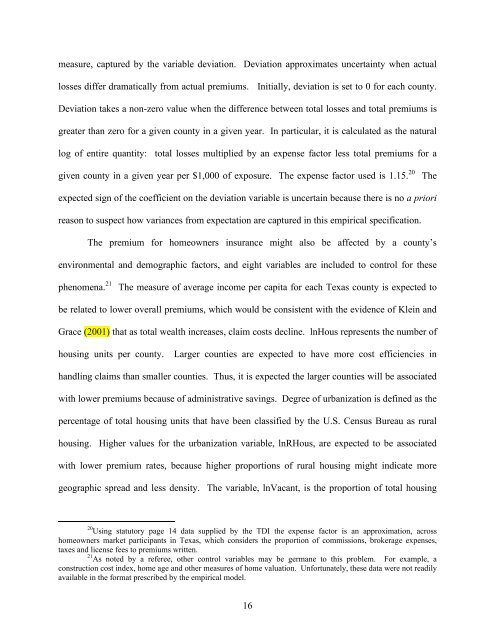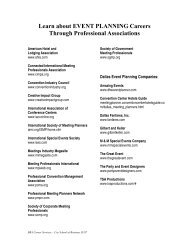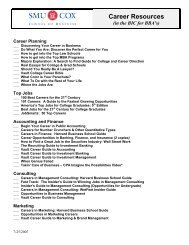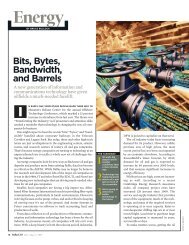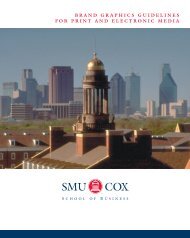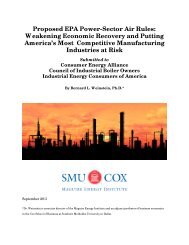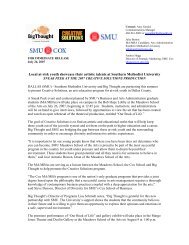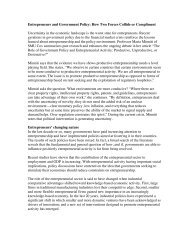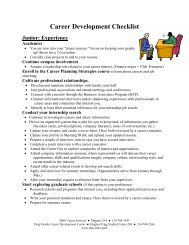Lessons from the Texas Homeowners Insurance Crisis Bob Puelz ...
Lessons from the Texas Homeowners Insurance Crisis Bob Puelz ...
Lessons from the Texas Homeowners Insurance Crisis Bob Puelz ...
Create successful ePaper yourself
Turn your PDF publications into a flip-book with our unique Google optimized e-Paper software.
measure, captured by <strong>the</strong> variable deviation. Deviation approximates uncertainty when actual<br />
losses differ dramatically <strong>from</strong> actual premiums. Initially, deviation is set to 0 for each county.<br />
Deviation takes a non-zero value when <strong>the</strong> difference between total losses and total premiums is<br />
greater than zero for a given county in a given year. In particular, it is calculated as <strong>the</strong> natural<br />
log of entire quantity: total losses multiplied by an expense factor less total premiums for a<br />
given county in a given year per $1,000 of exposure. The expense factor used is 1.15. 20 The<br />
expected sign of <strong>the</strong> coefficient on <strong>the</strong> deviation variable is uncertain because <strong>the</strong>re is no a priori<br />
reason to suspect how variances <strong>from</strong> expectation are captured in this empirical specification.<br />
The premium for homeowners insurance might also be affected by a county’s<br />
environmental and demographic factors, and eight variables are included to control for <strong>the</strong>se<br />
phenomena. 21 The measure of average income per capita for each <strong>Texas</strong> county is expected to<br />
be related to lower overall premiums, which would be consistent with <strong>the</strong> evidence of Klein and<br />
Grace (2001) that as total wealth increases, claim costs decline. lnHous represents <strong>the</strong> number of<br />
housing units per county. Larger counties are expected to have more cost efficiencies in<br />
handling claims than smaller counties. Thus, it is expected <strong>the</strong> larger counties will be associated<br />
with lower premiums because of administrative savings. Degree of urbanization is defined as <strong>the</strong><br />
percentage of total housing units that have been classified by <strong>the</strong> U.S. Census Bureau as rural<br />
housing. Higher values for <strong>the</strong> urbanization variable, lnRHous, are expected to be associated<br />
with lower premium rates, because higher proportions of rural housing might indicate more<br />
geographic spread and less density. The variable, lnVacant, is <strong>the</strong> proportion of total housing<br />
20 Using statutory page 14 data supplied by <strong>the</strong> TDI <strong>the</strong> expense factor is an approximation, across<br />
homeowners market participants in <strong>Texas</strong>, which considers <strong>the</strong> proportion of commissions, brokerage expenses,<br />
taxes and license fees to premiums written.<br />
21 As noted by a referee, o<strong>the</strong>r control variables may be germane to this problem. For example, a<br />
construction cost index, home age and o<strong>the</strong>r measures of home valuation. Unfortunately, <strong>the</strong>se data were not readily<br />
available in <strong>the</strong> format prescribed by <strong>the</strong> empirical model.<br />
16


